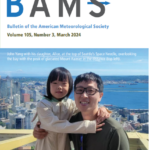ESSIC Scientist Santiago Gasso is first author on a new paper in Atmospheric Chemistry and Physics that provides an overview of aerosol sources of circular polarization in the atmosphere and discusses possible remote sensing signatures.
Upcoming satellite sensors will rely on linear polarization measurements to better detect aerosols. Yet current and planned polarimeters do not measure all polarization states. Last time such an instrument was deployed, it was in probes sent to study the atmospheres of Venus and Jupiter in the 1970s. Current technology advances make possible the deployment of more-cost effective satellite sensors with circular polarization capabilities. This review investigates a new way to observe aerosols and looks into the information that can be gained by measuring aerosol circular polarization remotely.
In addition to his role at ESSIC, Gassó is also a research associate at NASA Goddard. He specializes in observational studies of aerosols, clouds, and their interactions using a combination of satellite detectors. He has published several journal articles on the subject of dust transport at high latitudes as characterized by satellite, model, and surface observations.
To access the article, click here: “Circular polarization in atmospheric aerosols”.
To access the video abstract, click here: Video abstract.






